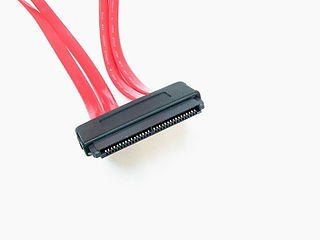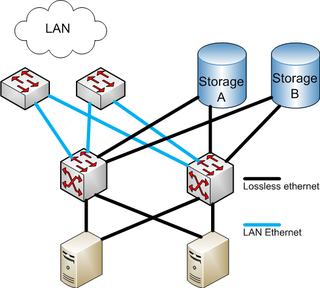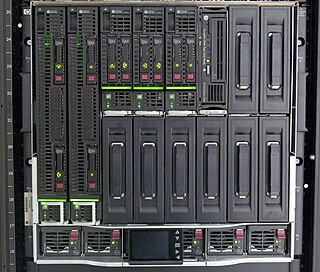In computing, iSCSI is an acronym for Internet Small Computer Systems Interface, an Internet Protocol (IP)-based storage networking standard for linking data storage facilities. It provides block-level access to storage devices by carrying SCSI commands over a TCP/IP network. iSCSI is used to facilitate data transfers over intranets and to manage storage over long distances. It can be used to transmit data over local area networks (LANs), wide area networks (WANs), or the Internet and can enable location-independent data storage and retrieval.
Fibre Channel (FC) is a high-speed data transfer protocol providing in-order, lossless delivery of raw block data. Fibre Channel is primarily used to connect computer data storage to servers in storage area networks (SAN) in commercial data centers.

In computer hardware, a host controller, host adapter, or host bus adapter (HBA), connects a computer, which acts as the host system, to other network and storage devices. The terms are primarily used to refer to devices for connecting SCSI, Fibre Channel and SATA devices. Devices for connecting to IDE, Ethernet, FireWire, USB and other systems may also be called host adapters.
In computing, the proposed Internet Storage Name Service (iSNS) protocol allows automated discovery, management and configuration of iSCSI and Fibre Channel devices on a TCP/IP network.

In computing, Serial Attached SCSI (SAS) is a point-to-point serial protocol that moves data to and from computer-storage devices such as hard disk drives and tape drives. SAS replaces the older Parallel SCSI bus technology that first appeared in the mid-1980s. SAS, like its predecessor, uses the standard SCSI command set. SAS offers optional compatibility with Serial ATA (SATA), versions 2 and later. This allows the connection of SATA drives to most SAS backplanes or controllers. The reverse, connecting SAS drives to SATA backplanes, is not possible.

The RapidIO architecture is a high-performance packet-switched electrical connection technology. RapidIO supports messaging, read/write and cache coherency semantics. RapidIO fabrics guarantee in-order packet delivery, enabling power- and area- efficient protocol implementation in hardware. Based on industry-standard electrical specifications such as those for Ethernet, RapidIO can be used as a chip-to-chip, board-to-board, and chassis-to-chassis interconnect..
A virtual storage area network is a logical representation of a physical storage area network (SAN). A VSAN abstracts the storage-related operations from the physical storage layer, and provides shared storage access to the applications and virtual machines by combining the servers' local storage over a network into a single or multiple storage pools.
Switched fabric or switching fabric is a network topology in which network nodes interconnect via one or more network switches. Because a switched fabric network spreads network traffic across multiple physical links, it yields higher total throughput than broadcast networks, such as the early 10BASE5 version of Ethernet and most wireless networks such as Wi-Fi.
Brocade is an American technology company specializing in storage networking products, now a subsidiary of Broadcom Inc. The company is known for its Fibre Channel storage networking products and technology. Prior to the acquisition, the company expanded into adjacent markets including a wide range of IP/Ethernet hardware and software products. Offerings included routers and network switches for data center, campus and carrier environments, IP storage network fabrics; Network Functions Virtualization (NFV) and software-defined networking (SDN) markets such as a commercial edition of the OpenDaylight Project controller; and network management software that spans physical and virtual devices.
In Fibre Channel protocol, a registered state change notification (RSCN) is a Fibre Channel fabric's notification sent to all specified nodes in case of any major fabric changes. This allows nodes to immediately gain knowledge about the fabric and react accordingly.

The IBM BladeCenter was IBM's blade server architecture, until it was replaced by Flex System in 2012. The x86 division was later sold to Lenovo in 2014.
Fibre Channel Protocol (FCP) is the SCSI interface protocol utilising an underlying Fibre Channel connection. The Fibre Channel standards define a high-speed data transfer mechanism that can be used to connect workstations, mainframes, supercomputers, storage devices and displays. FCP addresses the need for very fast transfers of large volumes of information and could relieve system manufacturers from the burden of supporting a variety of channels and networks, as it provides one standard for networking, storage and data transfer. Some Fibre Channel characteristics are:

Fibre Channel over Ethernet (FCoE) is a computer network technology that encapsulates Fibre Channel frames over Ethernet networks. This allows Fibre Channel to use 10 Gigabit Ethernet networks while preserving the Fibre Channel protocol. The specification was part of the International Committee for Information Technology Standards T11 FC-BB-5 standard published in 2009.

A storage area network (SAN) or storage network is a computer network which provides access to consolidated, block-level data storage. SANs are primarily used to access data storage devices, such as disk arrays and tape libraries from servers so that the devices appear to the operating system as direct-attached storage. A SAN typically is a dedicated network of storage devices not accessible through the local area network (LAN).

BladeSystem is a line of blade server machines from Hewlett Packard Enterprise that was introduced in June 2006.
In computer science, memory virtualization decouples volatile random access memory (RAM) resources from individual systems in the data centre, and then aggregates those resources into a virtualized memory pool available to any computer in the cluster. The memory pool is accessed by the operating system or applications running on top of the operating system. The distributed memory pool can then be utilized as a high-speed cache, a messaging layer, or a large, shared memory resource for a CPU or a GPU application.
Input/output (I/O) virtualization is a methodology to simplify management, lower costs and improve performance of servers in enterprise environments. I/O virtualization environments are created by abstracting the upper layer protocols from the physical connections.
Cisco Unified Computing System (UCS) is a data center server computer product line composed of computing hardware, virtualization support, switching fabric, and management software introduced in 2009 by Cisco Systems. The products are marketed for scalability by integrating many components of a data center that can be managed as a single unit.

The Dell blade server products are built around their M1000e enclosure that can hold their server blades, an embedded EqualLogic iSCSI storage area network and I/O modules including Ethernet, Fibre Channel and InfiniBand switches.
HP Virtual Connect brings virtualization to the blade server edge. It picks up where virtual machine technology stops. Virtual machine technology can only move workloads across virtual machines on a single server. It becomes a challenge when moving virtual machines from one physical machine to another or between data center locations, because changes to the LAN and SAN environments require manual intervention by network and storage administrators. By pooling and sharing multiple network connections across multiple servers and virtual machines, Virtual Connect extends Data Center capability by allowing physical setup and movement of Virtual Machine workloads between servers and Virtual Machines, transparently from the LAN and SAN infrastructure. Another name to Virtual Connect is PowerConnect Switches.







